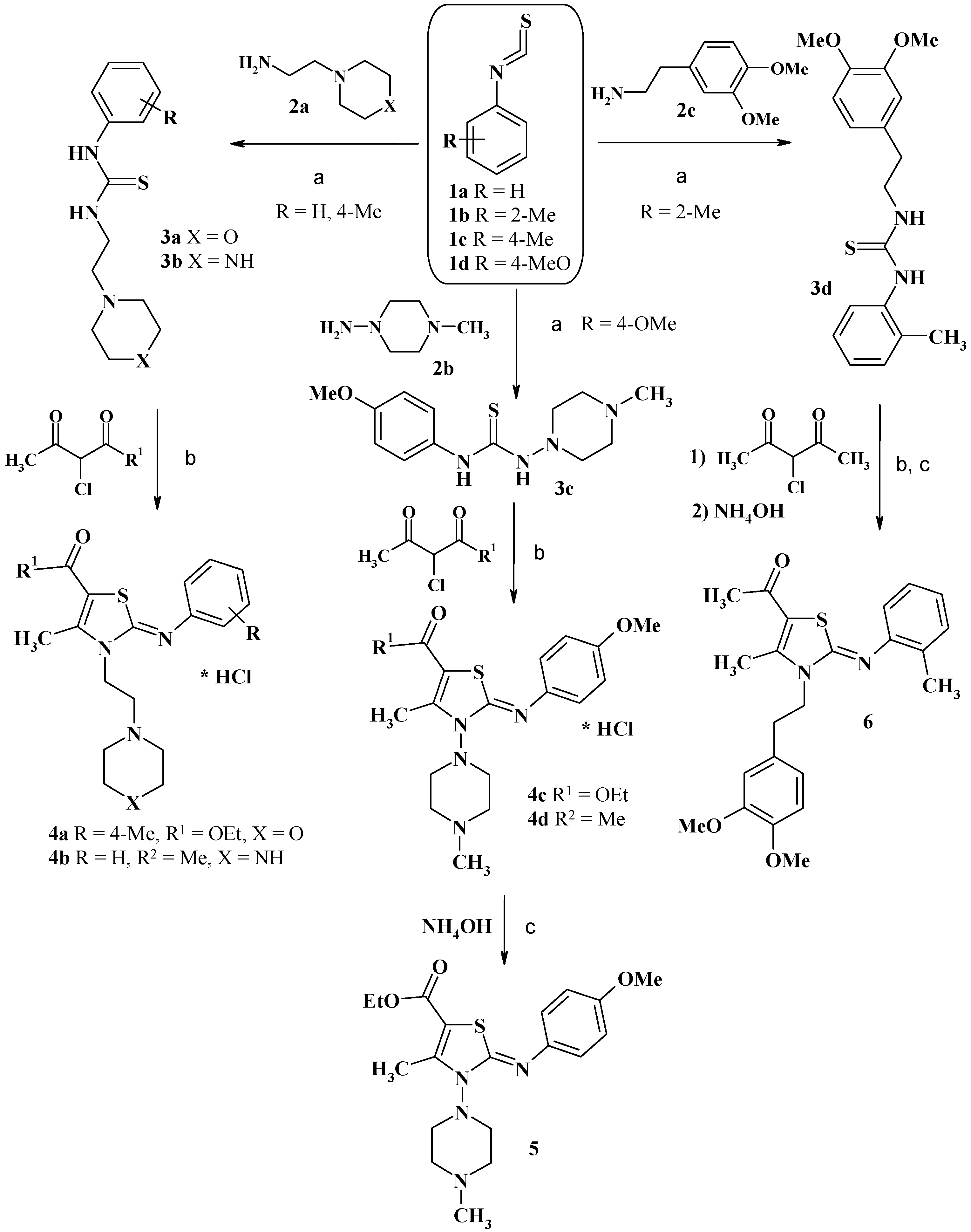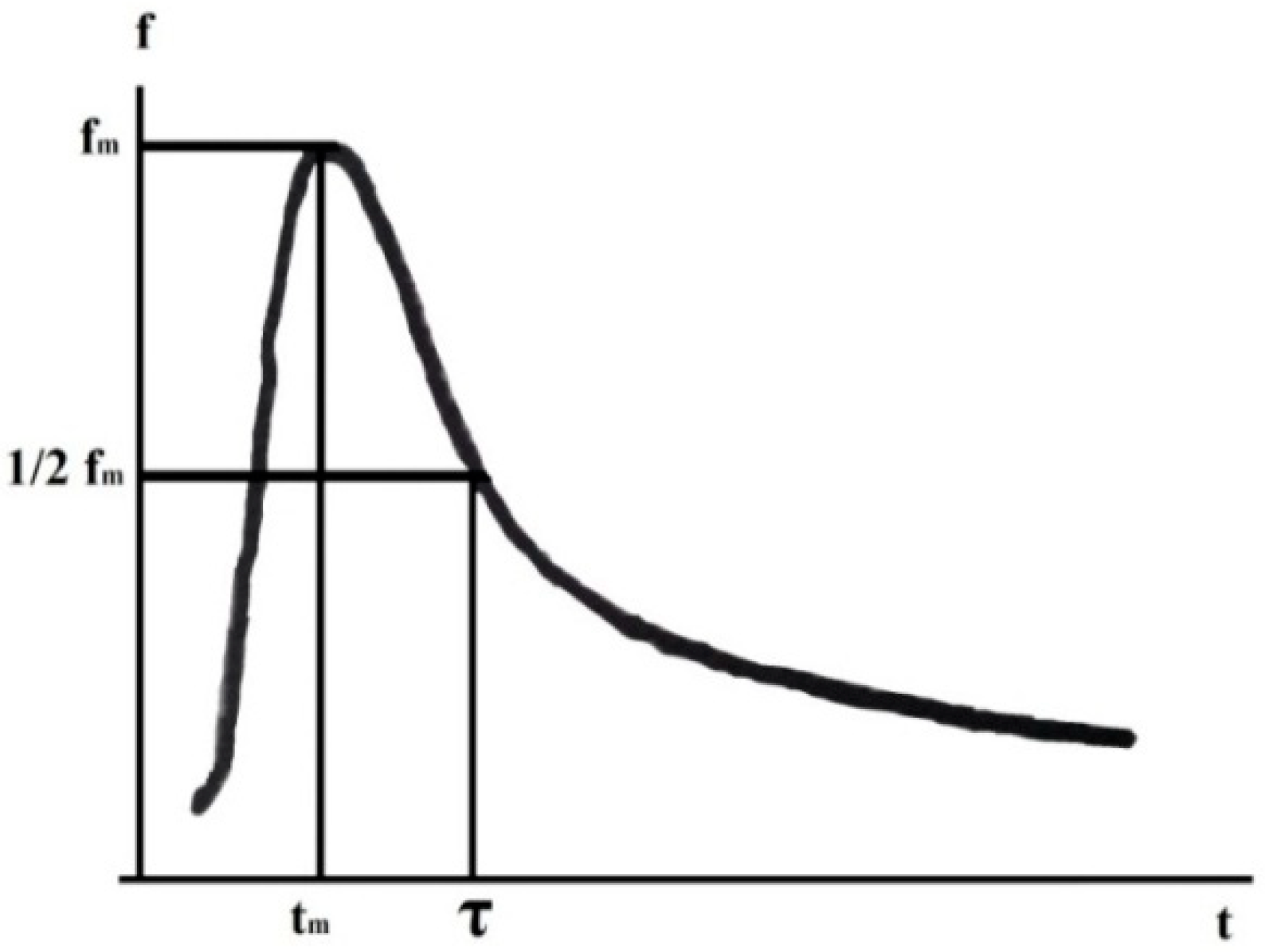Cardioprotective Activity of Some 2-Arylimino-1,3-Thiazole Derivatives
Abstract
1. Introduction
2. Materials and Methods
2.1. Chemistry
2.2. General Procedure for Synthesis of 2-Arylimino-1,3-Thiazoles (4a–c)
2.2.1. Ethyl-2-(4-Methylphenylimino)-4-Methyl-3-(Morpholinoethyl)-2,3-Dihydro-1,3-Thiazole-5-Carboxylate Hydrochloride (4a)
2.2.2. 1-[-2-(Phenylimino)-4-Methyl-3-[2-(Piperazine-1-yl)Ethyl]-2,3-Dihydro-1,3-Thiazole-5-yl] Ethan-1-One Hydrochloride (4b)
2.2.3. Ethyl-2-(4-Methoxyphenyl)imino]-4-Methyl-3-(4-Methylpiperazine-1-yl)-2,3-Dihydro-1,3-Thiazole-5-Carboxylate Hydrochloride (4c)
2.2.4. 1-[(2-[(4-Methoxyphenyl)imino]-4-Methyl-3-(4-Methylpiperazine-1-yl)-2,3-Dihydro-1,3-Thiazole-5-yl] Ethan-1-One Hydrochloride (4d)
2.3. Synthesis of 1-[2-[(2-Methylphenyl)imino]-4-Methyl-3-[2-(3,4-Dimethoxyphenyl)ethyl]-2,3-Dihydro-1,3-Thiazole-5-yl-Ethan-1-One (5)
2.4. Synthesis of Ethyl-[2-[(4-Methoxyphenyl)imino]-4-Methyl-3-(4-Methylpiperazin-1-yl)-2,3-Dihydro-1,3-Thiazole-5-Carboxylate (6)
2.5. Pharmacology
3. Results and Discussion
3.1. Chemistry
3.2. Pharmacology
4. Conclusions
Author Contributions
Conflicts of Interest
References
- Stern, C.S.; Lebowitz, J. Latest drug developments in the field of cardiovascular disease. Int. J. Angiol. 2010, 19, e100–e105. [Google Scholar] [CrossRef] [PubMed]
- Zhang, J.; Cui, X.; Yan, Y.; Li, M.; Yang, Y.; Wang, J.; Zhang, J. Research progress of cardioprotective agents for prevention of anthracycline cardiotoxicity. Am. J. Transl. Res. 2016, 8, 2862–2875. [Google Scholar]
- Kloner, R.A. Current state of clinical translation of cardioprotective agents for acute myocardial infarction. Circ. Res. 2013, 113, 451–463. [Google Scholar] [CrossRef] [PubMed]
- Li-Min, D.; Hong-Ying, Y.; Yan-Long, L.; Chun-Juan, J. Design and discovery of 2-(4-(1H-tetrazol-5-yl)-1H-pyrazol-1-yl)-4-(4-phenyl)thiazole derivatives as cardiotonic agents via inhibition of PDE3. Bioorg. Med. Chem. 2015, 23, 6111–6117. [Google Scholar] [CrossRef]
- Perekhoda, L.O.; Drapak, I.V.; Suleiman, M.M.; Sych, I.А.; Yaremenko, V.D. Synthesis and in silico research of derivatives of 3-allyl-4-(R-phenyl)-N-(R1-phenyl)-thiazole-2-imine. Der Pharma Chem. 2017, 9, 95–98. [Google Scholar]
- Baldwin, J.J.; Ponticello, G.S. Oxazoles and Thiazoles Containing an Aminohydroxypropoxyphenyl Moiety. U.S. Patent No. 4,735,961, 5 April 1988. [Google Scholar]
- Spada, A.P.; Fink, C.A.; Myers, M.R. Compounds Having Antihypertensive, Cardioprotective, Anti-Ischemic and Antilipolytic Properties. U.S. Patent No. 5,561,134, 1 October 1996. [Google Scholar]
- Richards, D.; Aronson, J.; Reynolds, D.J.; Coleman, J. Oxford Handbook of Practical Drug Therapy, 2nd ed.; Oxford University Press: Oxford, UK, 2011; pp. 2–196. [Google Scholar]
- Hernandez, M.A.; Rathinavelu, A. Basic Pharmacology: Understanding Drug Actions and Reactions; CRC: Boca Raton, FL, USA; London, UK, 2006; 369 p. [Google Scholar]
- Baumann, M.; Baxendale, I.R. An overview of the synthetic routes to the best selling drugs containing 6-membered heterocycles. Beilstein J. Org. Chem. 2013, 9, 2265–2319. [Google Scholar] [CrossRef] [PubMed]
- Bansal, Y.; Silakari, O. Multifunctional compounds: Smart molecules for multifactorial diseases. Eur. J. Med. Chem. 2014, 76, 31–42. [Google Scholar] [CrossRef] [PubMed]
- Bi, W.; Cai, J.; Liu, S.; Baudy-Floch, M.; Bi, L. Design, synthesis and cardioprotective effect of a new class of dual-acting agents: Phenolic tetrahydro-β-carboline RGD peptidomimetic conjugates. Bioorg. Med. Chem. 2007, 15, 6909–6919. [Google Scholar] [CrossRef] [PubMed]
- Demchenko, A.M.; Yanchenko, V.A.; Kisly, V.V.; Lozinskii, M.S. Use of Tetramethylthiuram Disulfide in Synthesis of Nitrogen-containing Heterocyclic Compounds. Chem. Heterocycl. Compd. 2005, 41, 668–672. [Google Scholar] [CrossRef]
- Yeromina, H.O.; Drapak, I.V.; Perekhoda, L.O.; Yaremenko, V.D.; Demchenko, A.M. Synthesis of 2-(4-aryl(adamantyl)-2-phenyliminothiazol-3-yl)-ethanol derivatives and prediction of their biological activity. Der Pharma Chem. 2016, 8, 64–70. [Google Scholar]
- Venkatachalam, T.K.; Uckun, F.M. Synthesis of Symmetrical and Asymmetrical Phenethyl Thiourea Compounds as Nonnucleoside Inhibitors of HIV-1 Reverse Transcriptase. Synth. Commun. 2005, 35, 2039–2056. [Google Scholar] [CrossRef]
- Esteves-Souza, A.; Pissinate, K.; Nescient, M.; Grynberg, N.F.; Echevarria, A. Synthesis, cytotoxicity, and DNA-topoisomerase inhibitory activity of new asymmetric ureas and thioureas. Bioorg. Med. Chem. 2006, 14, 492–499. [Google Scholar] [CrossRef] [PubMed]
- Taha, M.; Ismail, N.H.; Jamil, W.; Khan, K.M.; Salar, U.; Kashif, S.M.; Rahim, F.; Latif, Y. Synthesis and evaluation of unsymmetrical heterocyclic thioureas as potent β-glucuronidase inhibitors. Med. Chem. Res. 2015, 24, 3166–3173. [Google Scholar] [CrossRef]
- Yeromina, H.O. The Search for New Biologically Active Substances among 2-R-Phenyliminothiazole Derivatives; National University of Pharmacy: Kharkiv, Ukraine, 2017. [Google Scholar]
- Vogel, H.G. Chapter A: Cardiovascular activity. In Drug Discovery and Evaluation: Pharmacological Assays; Springer: Berlin/Heidelber, Germany, 2008; pp. 47–391. [Google Scholar]
- Burdyga, V.; Kosterin, S.A. Kinetic analysis of smooth muscle relaxation. Gen. Physiol. Biophys. 1991, 10, 589–598. [Google Scholar] [PubMed]
- Dinicolantonio, J.J.; Lavie, C.J.; Fares, H.; Menezes, A.R.; O’Keefe, J.H. L-carnitine in the secondary prevention of cardiovascular diseases: Systematic review and meta-analysis. Mayo Clin. Proc. 2013, 544–551. [Google Scholar] [CrossRef] [PubMed]
- Sjakste, N.; Gutcaits, A.; Kalvinsh, I. Mildronate: An Antiishemic Drug for Neurological Indications. CNS Drug Rev. 2005, 11, 151–168. [Google Scholar] [CrossRef] [PubMed]


| Compound | Vnc (M ± m) |
|---|---|
| 4a | 0.081 ± 0.007 |
| 4b | 0.035 ± 0.006 |
| 4c | 0.027 ± 0.003 |
| 4d | 0.085 ± 0.010 |
| 5 | 0.093 ± 0.012 |
| 6 | 0.087 ± 0.013 |
| l-carnitine | 0.033 ± 0.005 |
| Meldonium | 0.031 ± 0.004 |
| Nagative Control Value | 0.062 ± 0.019 |
© 2019 by the authors. Licensee MDPI, Basel, Switzerland. This article is an open access article distributed under the terms and conditions of the Creative Commons Attribution (CC BY) license (http://creativecommons.org/licenses/by/4.0/).
Share and Cite
Drapak, I.; Perekhoda, L.; Demchenko, N.; Suleiman, M.; Rakhimova, M.; Demchuk, I.; Taran, S.; Seredynska, N.; Gerashchenko, I. Cardioprotective Activity of Some 2-Arylimino-1,3-Thiazole Derivatives. Sci. Pharm. 2019, 87, 7. https://doi.org/10.3390/scipharm87010007
Drapak I, Perekhoda L, Demchenko N, Suleiman M, Rakhimova M, Demchuk I, Taran S, Seredynska N, Gerashchenko I. Cardioprotective Activity of Some 2-Arylimino-1,3-Thiazole Derivatives. Scientia Pharmaceutica. 2019; 87(1):7. https://doi.org/10.3390/scipharm87010007
Chicago/Turabian StyleDrapak, Iryna, Lina Perekhoda, Natalya Demchenko, Marharyta Suleiman, Maryna Rakhimova, Inna Demchuk, Svitlana Taran, Nataliya Seredynska, and Inna Gerashchenko. 2019. "Cardioprotective Activity of Some 2-Arylimino-1,3-Thiazole Derivatives" Scientia Pharmaceutica 87, no. 1: 7. https://doi.org/10.3390/scipharm87010007
APA StyleDrapak, I., Perekhoda, L., Demchenko, N., Suleiman, M., Rakhimova, M., Demchuk, I., Taran, S., Seredynska, N., & Gerashchenko, I. (2019). Cardioprotective Activity of Some 2-Arylimino-1,3-Thiazole Derivatives. Scientia Pharmaceutica, 87(1), 7. https://doi.org/10.3390/scipharm87010007





